Blocking the path of the enemy. Mine spreaders and barriers. Part two
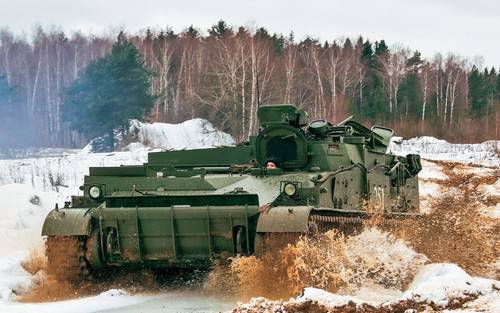
The very logic of combat operations set the task of developing a mine layer with an armored hull, which would allow him to set up barriers without fearing the enemy’s response fire from at least weapons, and blows of splinters, thereby protecting the crew and ammunition during the execution of a combat mission. The armored defense also allowed the minelayer to put minefields, as they say, right under the enemy’s nose, not allowing him time to maneuver.
The basic machine for the new loader was a self-propelled 100-mm post-war development gun SU-100P (“Object 105”). This artillery system was adopted, but in 1949-1957. only 24 pieces were manufactured, and in connection with the opinion of the First Secretary of the Central Committee of the CPSU N.S. Khrushchev that missiles are able to replace and Aviation, and artillery, it was abandoned. However, on the basis of this artillery system in 1960, the creation of the GMZ crawler mines - the “Object 118” began. Design and development work on the creation of the GMZ was set by Decree of the Council of Ministers of the USSR of February 4, 1956. It was adopted by order of the Minister of Defense of the USSR of February 22, 1960 and in 1961-1969. serially produced at UZTM. A self-propelled tracked vehicle was used as the basic chassis - item 123, a special modified chassis of the former Su-100P installation.
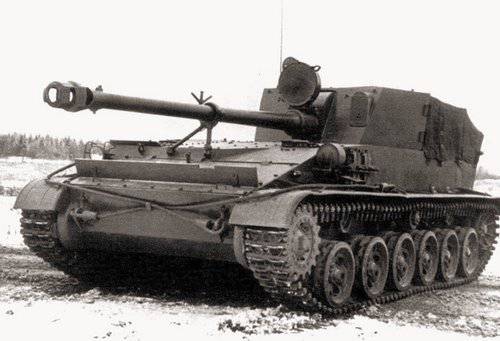
A minelayer was developed at the Uralmashzavod design bureau 3, chief designer Georgiy Sergeevich Efimov. Supervised the work of the deputy. chief designer E.A. Karlinsky. The leading design engineers following each other were: Yu.A. Simonyan, Yu.M. Nikitin and Yu.P. Sarapultsev.
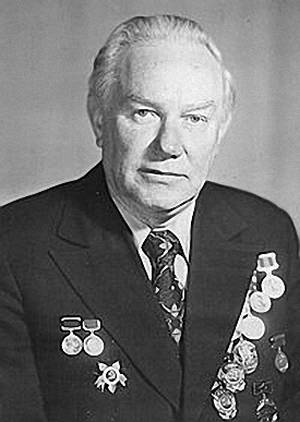
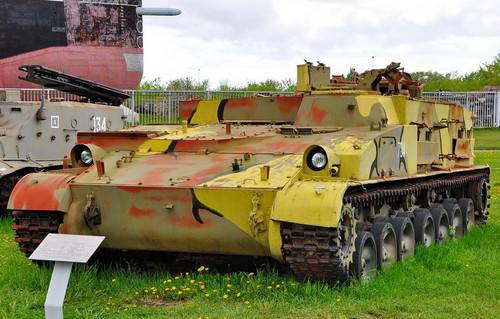
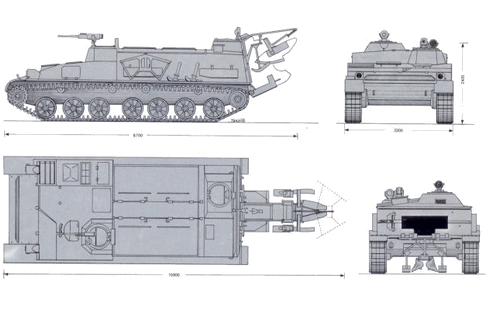
Structurally, the machine is divided into four compartments: engine, control, mine and operator. In the control compartment, which is located in the left (along the vehicle) half of the forward part of the hull, the driver’s position of the mechanic and the vehicle commander are located. The operator is located in the aft compartment, where he manages the issue of mines. In the stern of the haulier's hull there is an installation with a mine delivery tray and a plow-masking device.
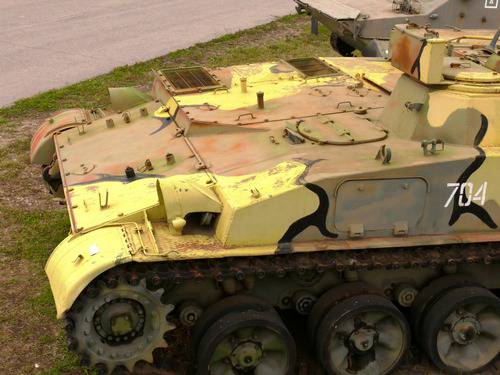
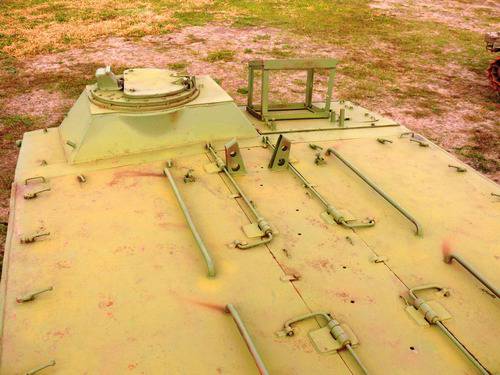
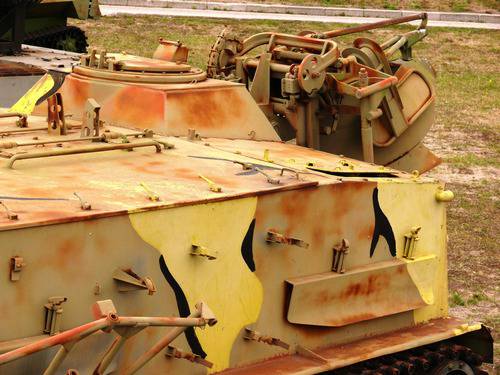
The body of the machine is sealed, equipped with FVU, which allows you to work on chemically or radioactively contaminated areas. The crew of the car are three people - the commander of the car, the driver and operator. The main weapon used 7,62-mm PKT machine gun. Ammunition is 1000 cartridges. To install a minefield GMZ equipped with anti-tank mines TM-57, TM-62. Mines are equipped with contact and non-contact (for TM – 62) fuses. The cart is 208 min.
The delivery of mines to the laying mechanism is carried out by a belt conveyor through a window in the lower part of the rear sheet of the machine body. The movement of the conveyor belt is synchronized with the movement of the tracks. At changes in the speed of the machine’s movement, the accuracy of the laying of the mines does not change and the operator’s mining step is observed.
Mines in the mine compartment are inserted into special sections. Each section holds 4 mines. Thirteen sections are one row, and there are four such rows in the mine compartment. Thus, the total number of mines is 208 pcs.
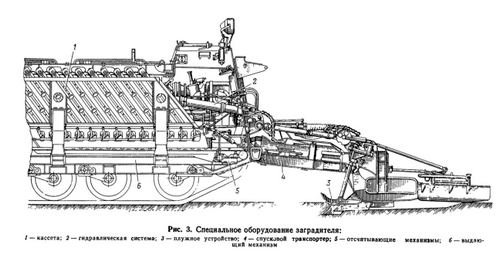
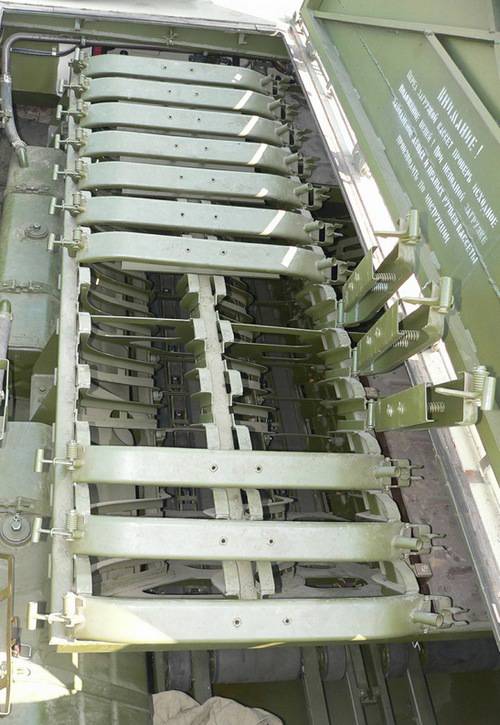
Mines are inserted into sections in such a way that the fuses are directed to the stern of the barrier layer, then they come out correctly - fuses up. After the mines are loaded, the minelayer is ready to set up the minefield. When approaching the line of mining, the operator lowers the plow device and the trigger conveyor to the semi-transport position and opens the covers of the mined windows. After reaching the place of work (minefield installation), the operator lowers the plow unit to the working position, sets the gear lever, depending on the mining step, to the 4 or 5,5 position. The operator also controls the actions of the mechanic input, watching the release of mines, and sets the speed of mining. After the last mine leaves the operator’s console, the yellow lamp “Kit issued” lights up. The plow device and the trigger vehicle are raised to the semi-transport position.
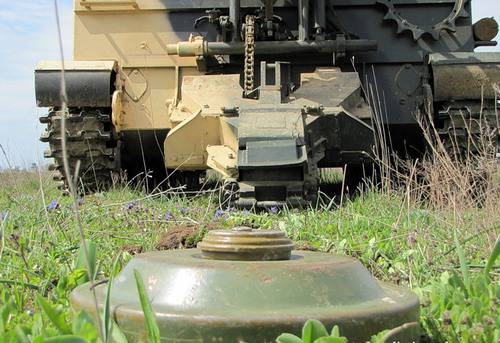
The recharge time of the machine is from 15 to 40 minutes. For this, it is required to attract another sapper platoon who prepares the mines for laying (opens the boxes, equips the mines with fuses and gives the mines to the calculation to the top).
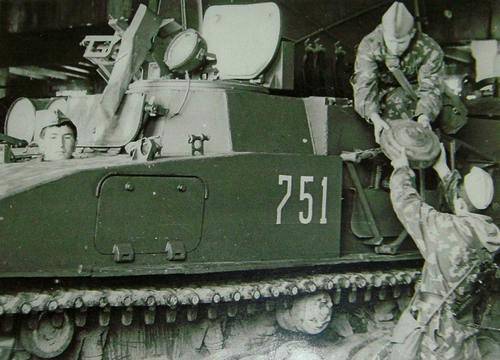
The laying of mines in the soil is carried out only in the first gear (on the ground in the first and second) and only in soils of the І - ІІI category of density. It is not allowed to install mines in stony, rubble and frozen soils.
GMZ had to take part in hostilities. This happened for the first time in Afghanistan, where they ended up either by chance, or by stupidity, or simply as a regular unit of the engineer-sapper battalion of the division. But tanks the spirits did not have, and therefore there was no place to use the mechanized installation of minefields. And after a couple of equipped GMZs were shot, and a decent-sized funnel remained in place, they quickly decided to hide all the mines, removed mine cassettes and used the loader as a transport. Even the spirits were afraid to shoot these cars, mindful of those bombings. After all, if two tons of TNT explode, then the arrow will not seem enough. And so they drove motorized rifles.
At the beginning of the 1990's. 3 tracked minelayers were in service with the Transnistrian armed forces and participated in 2 March 1992 in local battles. One car was destroyed. More detailed information is not available. But judging by the photo below, it was not GMZ, but GMZ-2.
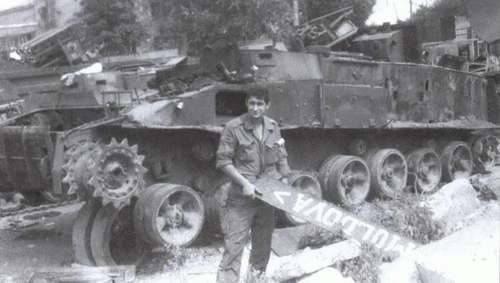
Main TTX GMZ:
Types of mines used:
- TM-57 with fuses MVZ-57
- TM-62 with fuses MVZ-62
The total mass of the minelayer is 28,5 t,
Overall dimensions in working position:
Length - 8,62 m.
Width - 3,25 m.
Height - 2,7 m.
Track - 2,72 m.
The average speed on dirt roads is 25 – 27 km / h.
Mining speed:
- when mines are placed on the surface - up to 16 km / h.
- when installed in the ground (snow) - up to 6 (10) km / h.
The mining step is 4 or 5.5 m.
Ammunition min - 208 pcs.
Crew - 3 people.
Armor thickness - 15 mm
Years of release: 1960-1968.
In 1962, the design bureau of UZTM began work on the further improvement of the tracked mine layer. This is how the second-generation barrier was born. HMZ-2 ("118M Object"), which was supposed to replace GMZ. The machine was put into service by order of the head of the engineering troops of the USSR Ministry of Defense from December 14 1967.
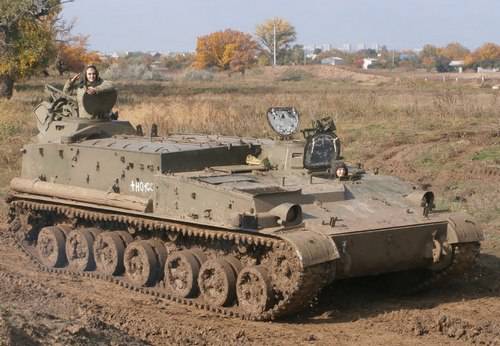
The main purpose of the machine GMZ-2, like GMM, is the mechanized installation of anti-tank mines. Mines can be installed in the ground and in the snow. At the same time, mines can be both disguised and placed on the ground surface.
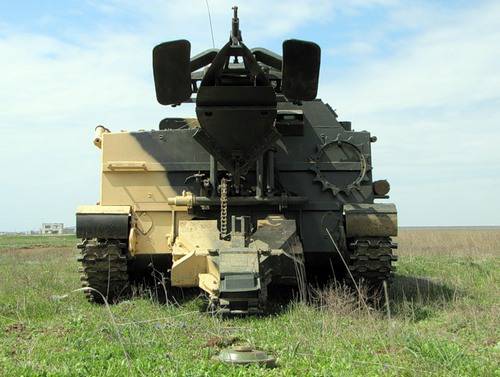
A significant disadvantage of the GMZ was that if only part of the ammunition was consumed during mining, recharging was impossible. It was necessary to lay out all the ammunition, to be able to charge the car again. This flaw was eliminated in a modified version of the machine. In addition, HMZ-2 provided for the possibility of switching off the mechanism for bringing the fuses to the firing position, which made it possible to use the machine to place mines with other fuses (in this case, fuses were manually put into the firing position).
Engine power in GMZ-2 was increased to 520 hp, which allowed to raise the transport speed to 60 km / h.
The crew consists of three people: a driver, a car commander and an operator. The armored body of the vehicle has easy booking and protects the crew from bullets and debris, and also has anti-nuclear protection and protects the crew from the shock wave during a nuclear explosion.
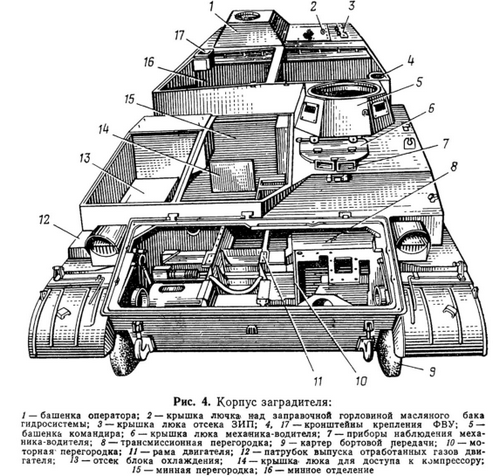
The housing of HMP-2 has four compartments: the control compartment, power, mine, operator compartment. In the nasal compartment between the partition of the power compartment and the left side there is a control compartment in which the driver’s seat is located, as well as the levers and pedals of the machine control drives. In the roof of the department of management there are hatches of the driver and commander of the machine. Behind the place of the driver on the left side is the place of the commander of the machine, over which the turret is installed with the PCT installation.
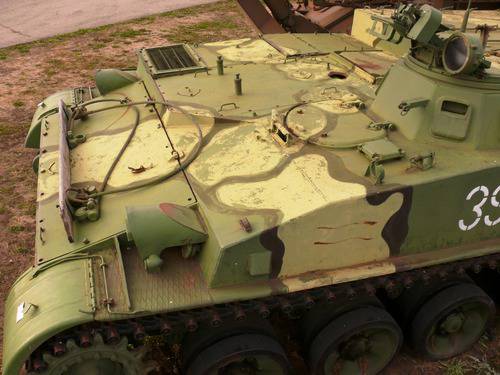
In the middle part of the housing GMZ-2 is a mine compartment. The mine department has a mechanism for issuing mines and a mine cassette. On the sides of the compartment are fuel tanks. Two on the starboard side and one on the left. For equipment of cassettes with mines, as well as for refueling the machine on the roof of the mine compartment there are opening flaps. An antenna is installed on the roof in front of the mine compartment. Also in the mine compartment installed filtering unit and part of the portable kit spare parts.
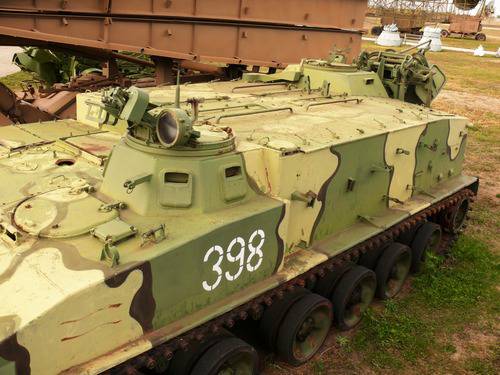
The operator’s compartment is located at the rear of the housing above the outstanding mechanisms. In the operator’s compartment there are hand drives with a min dispensing mechanism, an operator console with mechanisms for closing the exit min windows, as well as the operator’s turret, which has a hatch and monitoring devices.
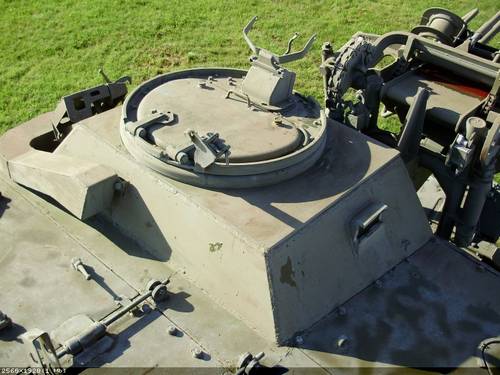
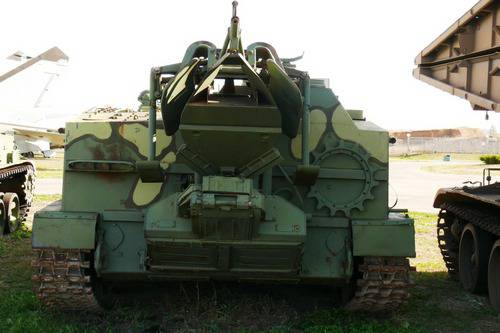
In the previous version of the GMZ, there were no observation devices, so the operator was forced to lean out of the hatch to control the laying of mines, which was unsafe. As the main armament used 7,62-mm tank gun PKT. Ammunition is 1500 cartridges.
For the installation of a minefield, GMZ-2 is equipped with anti-tank mines TM-57, TM-62М, TM-62П2 and TM-62Т. Mines are equipped with contact and non-contact (for TM - 62) fuses. The cart is 208 min.
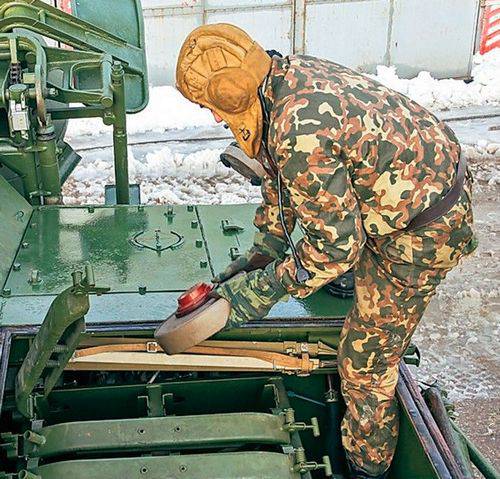
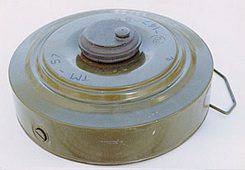
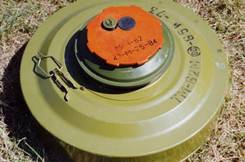
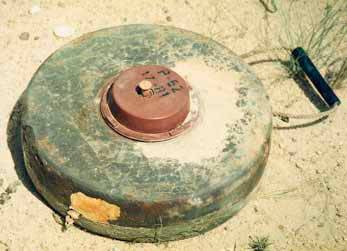
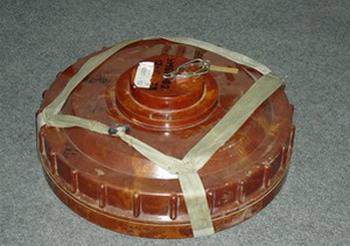
Three prism surveillance devices, periscope binocular instruments TKN-3A, and infrared lamps OU-3HK were installed in the turrets of the commander and operator to monitor the terrain and aimed fire from a machine gun.
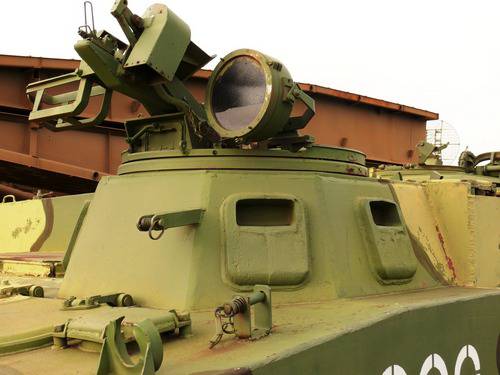
The driver has two prism surveillance devices and the TVN-2BM periscope binocular device. To provide external communication, the R-2М radio station has been installed in the HMZ-123, the range of which in medium terrain is up to 20 km. For internal negotiations in the car has a tank intercom.
The power plant used modified diesel engine B-54, designated B-105-B. The gearbox is manual, has 6 front and 2 reverse gears. The external difference between the GMZ-2 and the State Museum Reserve is the presence of surveillance devices on the machine commander’s tower and on the operator’s tower.
Differences from the first generation GMZ:
- it became easier on 1 ton;
- with the same width and height became longer by almost 70 cm;
- The suspension has changed (became completely torsion).
GMZ-2 was in service with a platoon of the GMZ of the engineering battalion of the division.
At the end of 1980-x on the basis of GMM - 2, a universal tracked minelayer UGMZ was developed, designed for remote mining of anti-personnel mines PFM-1 and PFM-1С.
The main TTX GMZ-2:
Crew - 3 person.
Combat weight - 27,5 t.
Length - 9,3 m,
Width - 3,25 m,
Height - 2,7 m,
Ground clearance - 450 mm.
Armament: 7,62-mm machine gun,
Ammunition - 1250 ammunition, 208 min TM-62М, TM-57.
Armor thickness: bulletproof - 15 mm, feed 12 mm.
Maximum speed - 63 km / h.
Cruising on fuel - 450 km.
Diesel engine, power - hp 520
Mining speed:
on the ground - 15 km / h,
to ground - 6 km / h,
in the snow - 10 km / h.
The mining step is 5 or 10 m.
The length of the single-row MP - 1080 m.
With mines with proximity fuse - 2000 m.
But HMP-2 was also not perfect, so in 1984, it comes into service HMZ-3 (318 object)developed by UZTRM. Differences from previous machines:
- removed the system of thermal smoke equipment due to too much fuel consumption for the formation of smoke and the impossibility of smoke machine, standing on the spot. Instead, 6 81-mm “Tucha” grenade launchers are installed on the sides for setting smoke screens;
- removed anti-nuclear protection system as superfluous;
- added the ability to install anti-tank mines TM-89 with a magnetic fuse.
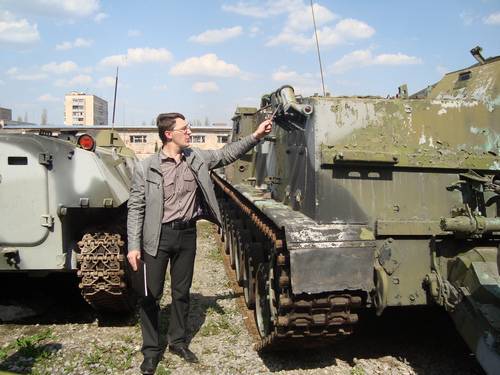
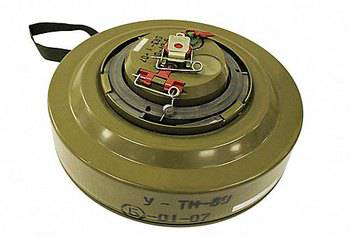
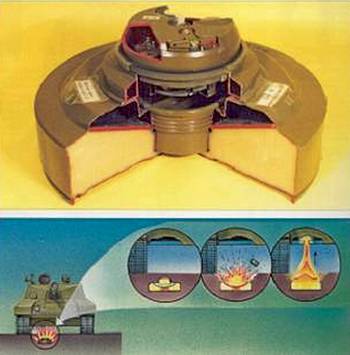
The first demonstration of the GMZ-3 "Wind" was held at the RDE-2001 exhibition in Nizhny Tagil, Sverdlovsk region. GMZ-3 is equipped with modern navigation tools (inertial and satellite), which provides continuous processing of the course of the machine, finding the shortest path, digital indexing of the coordinates of the machine and coordinates of the nodal points of the minefield, the coordinates of each mine. All this allows the fixation of the minefield at the moment of mining, drawing the contours of the minefield on a topographic map and the simultaneous transfer of the coordinates of the minefield to the combat command center of the combined-arms part. The crew consists of 3 people: the commander, the driver and operator. Armor HMZ-3 is quite thin - millimeters 15, which protects against small arms and shell fragments. The laying of mines takes place on the ground or in the ground with a specified mining step. The mining speed ranges from 6 to 16 km / h, and the length of the laid out minefield by one charge is up to 1000 meters from mines with contact fuses and to 2000 meters from mines with proximity fuses. GMZ-3 is equipped with a self-digging device, which allows to produce a mechanized passage for a car in medium soils.
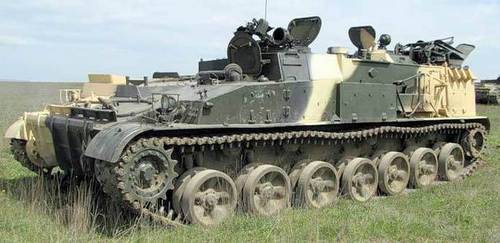
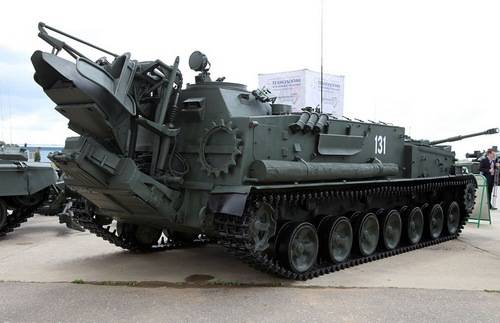
GMZ-3 taken into service with a platoon of barriers of the engineering battalion. In the states of some divisions, at the end of the eighties, a squad of GMZ was put into the staff of an engineering company of a motorized rifle or tank regiment. Such a platoon in a quarter of an hour can expose a three-row minefield with a length of 1000 — 2500 meters. According to the general tactics, a platoon of the GMZ in combat was a mobile detachment of the division barrage, and advanced in the direction of the enemy tanks' breakthrough.
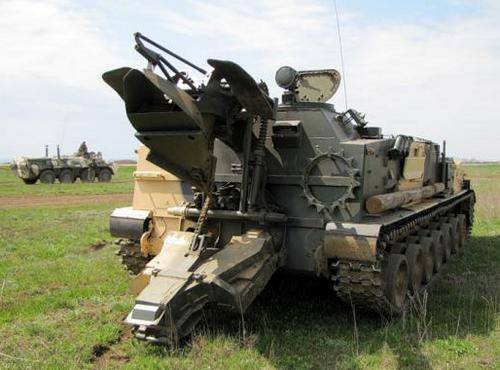
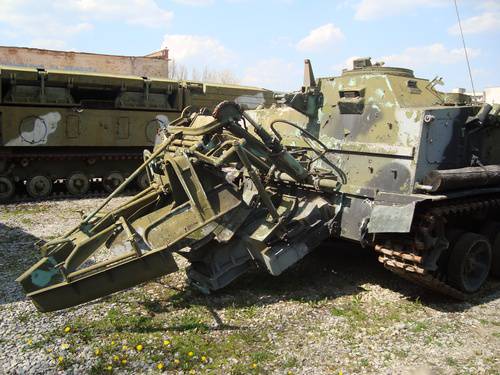
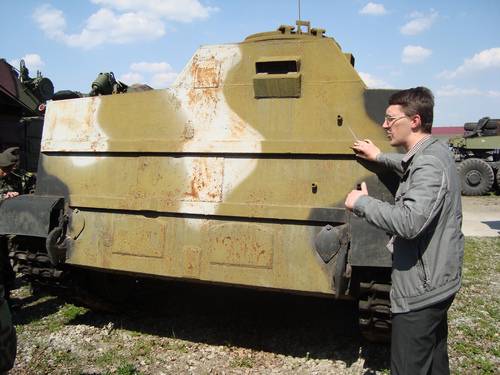
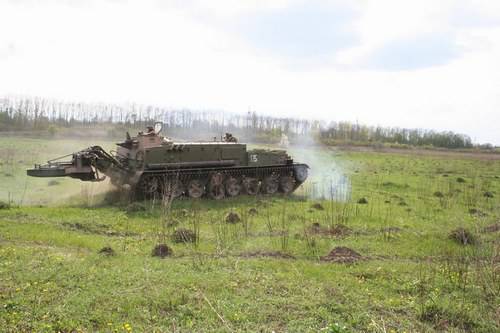
HMZ-3 ensures the advance installation of minefields in the expected tank-hazard directions, as well as in the direct reflection of attacks by enemy tank and mechanized units. To date, GMZ-3 took part in the battles in the east of Ukraine on both sides. Detailed information on specific tasks and their effectiveness is still closed. Only photos from those places.
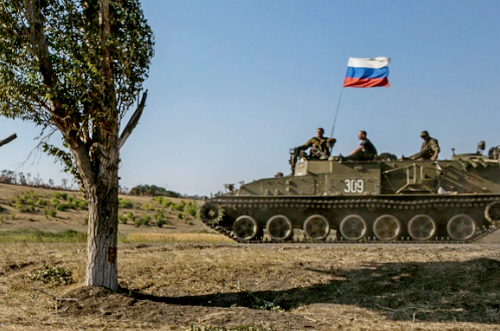
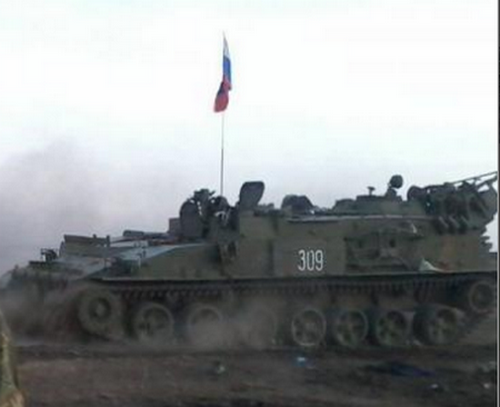
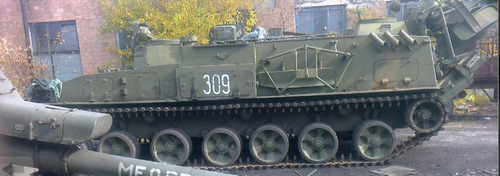
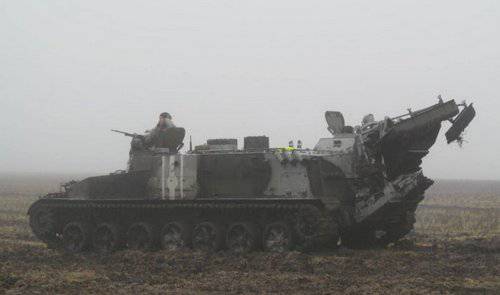
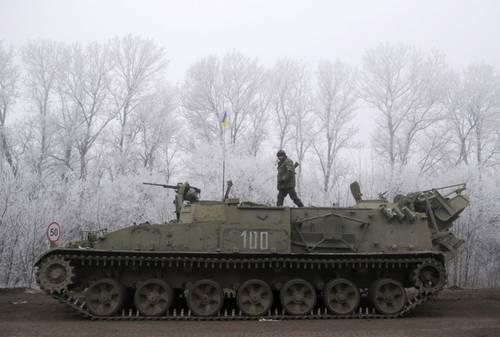
The disadvantage of GMZ-3 military experts consider it a fairly easy booking. In addition, modern technologies already allow the use of remote mining method. There were publications in the electronic media that, on the basis of the Armat platform, apart from the main tank, the heavy infantry fighting vehicle and the evacuation vehicle, other equipment would be created, in particular, the universal minelayer (UMP-A) of the new generation. Just these machines will be equipped with remote mining equipment integrated into the tactical level automated control systems. If necessary, these "destroyers" in a matter of minutes will cover the direction in which the enemy equipment may appear. This circumstance should significantly complicate the actions of any aggressor.
The main TTX GMZ-3:
Combat weight - 28,5 t.
Crew - 3 people.
Hull length - 9,3 m.
Case width - 3,25 m.
Height - 2,7 m.
Track - 2,7 m,
Clearance - 0,45 m.
Type of armor - bulletproof 15 mm.
Engine Type - Diesel
Engine power - 520 l. from.
Speed on the highway - 60 km / h.
Cruising on the highway - 500 km.
Overcoming rise - 30 hail.
Breakable wall - 0,7 m.
Overcoming ditch - 2,5 - 3 m.
Overcoming ford - 1, m.
Information